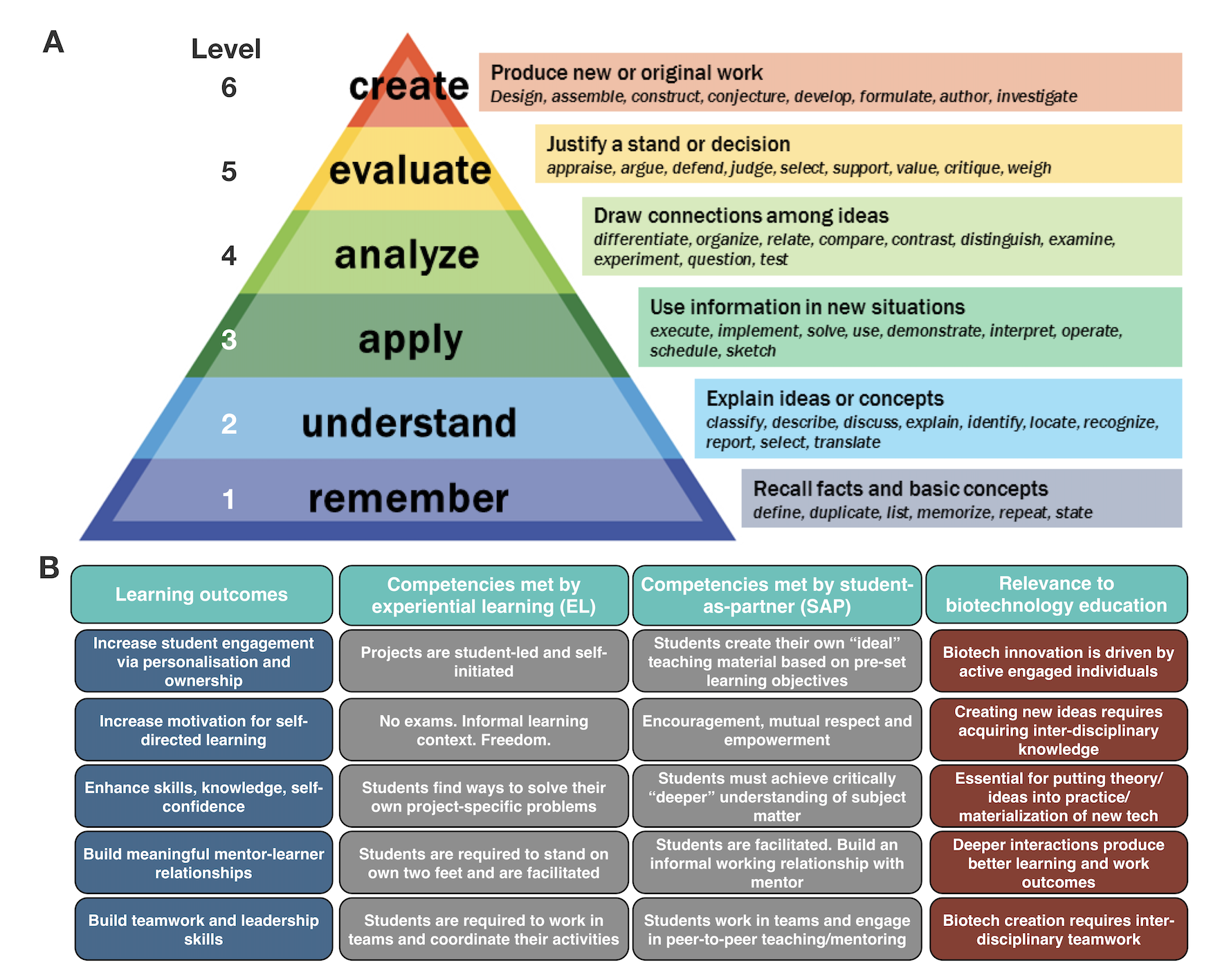biodatascience
This is the web resource for NTU's Bio-Data Science and Education Laboratory
High-impact pedagogical practices
While AI-driven education is a powerful paradigm shift, it may raise questions on how teaching practices should co-evolve with (and not merely rely passively on) AI. Bloom’s taxonomy (BT), a levelling system for learning outcomes (Figure 1A) – is a useful basis for this discussion.

BT suggests that high level outcomes (create) are built on lower level outcomes (remember). Human work that draws on learning acquired at BT levels 1-3 may be substituted by AI. From the perspective of training novices, AI-AL can help novices scale BT levels faster, since they may, concurrent to their learning at lower BT levels, use AI to perform tasks to generate outputs for higher BT level training. As the learners gain solid foundation (i.e. attained lower BT levels), they can move on to higher-level deployment by synergizing with AI technologies to promote creativity and innovation. By then, they would have sufficient knowledge base to properly evaluate AI outputs for accuracy and value. With this advantage of AI in scaling the lower BT levels, adopting pedagogical approaches that focus more on honing BT levels 4-6 of human capacity is critical towards achieving better synergy with AI-driven education, particularly, to “action-ate” on connections AI makes in the network of knowledge.
The ability to “action-ate” is a skill and can be taught via high impact practices (HIPs) in pedagogy. HIPs focus on creative application of knowledge and self-directed learning. Their minimally didactic frameworks encourage deeper and more meaningful learning through self-acquisition of know-hows, and their simulation of real life practice in a team-based setting allows learners to develop communication/group dynamics handling skills (relevant to BT levels 4-6). We have been exploring the use of various HIPs for use in the university education setting. We currently investigate the use of experiential learning (EL) and student-as-partner (SAP) (Figure 1B).
###Experiential learning (EL) EL reinforces learning from authentic experience through an iterative cycle of reflective observation, abstract conceptualization and active experimentation. Students are put through real life scenarios where they have to problem-solve themselves on a regular basis, drawing on anything and everything deemed relevant (without disciplinary boundaries). An EL course Fieldwork and Documentation in Nanyang Technological University, for example, requires students to come up with questions of socio-cultural interest to investigate during an overseas study trip. They therefore needed to conduct interviews of the local community and collate observation, the data of which would be processed and deliberated for presentation via video documentaries or static exhibits. The varied scope of the tasks challenged the students beyond head knowledge and they were highly engaged, gaining considerable competence and confidence in the process. EL projects requiring experimentation to develop products, e.g. mechanical gadgets, culinary dishes, etc. are potentially suitable for biotechnology learners as it layers systematic optimization onto out-of-box thinking and purpose-driven designing that conventional laboratory practicals are unable to. EL brings about a sensitivity towards the interconnectedness of variables and disciplines together with creative “action-ation”, essential traits for co-evolving with AI.
###Student-as-partners (SAP) SAP involves co-learning, co-development of curriculum and co-teaching to deepen personal learning, as students are coerced into thinking more deeply about the subject matter from a teacher’s perspective. In one example, the Department of Mathematical Sciences, Loughborough University recruited second-year undergraduate students as interns to produce teaching and learning resources for future cohorts of the same level, to redesign two of its historically problematic modules (vector spaces and complex variables) with the aim of enhancing student experience and engagement. The subsequent ethnographic study showed that the interns became significantly more engaged and interested, gaining a deeper understanding of the mathematics they worked on. The “teaching” role forces them to critically examine new knowledge against what they think they know. Achieving learning depth and competency is essential for “action-ating” as it helps build firmer knowledge foundations and importantly, fosters closer working relationships with mentors and peers. In biotechnology education, having senior students teach about technology which may have been relegated in their minds simply as “convenient tools”, e.g. DNA sequencers, can bring about a dimension of complexity in thinking. It may at the same time address the foreseeable pitfall of students blindly relying on AI-driven biotechnology as these become prevalent.
Even with AI-enabling, the gap between theory and action will persist as this ultimately is a human problem. AI can help smoothen learning processes via AL, or provide new ideas. The “step-up” lies in cultivating self-reliant individuals with a penchant for deep learning and creative “action-ation”. These are skills teachable via HIPs. EL and SAP are especially invaluable as they elevate student engagement via personalization and ownership with less emphasis on grades and credits amongst other competencies (Figure 2B). These in turn, are relevant towards biotechnology because self-directed learning, creative “action-ation” and aptitude for cross-disciplinary teamwork are crucial in the multi-disciplinary, collaborative, and rapidly changing field of biotechnology.
Team members
- Chun Chau Sze
- Sophia Tan
- Justin Ng
- Ho Sung Yang
- Wilson Wen Bin Goh
Relevant publications
- Goh WWB, Sze CC. AI paradigms for teaching biotechnology. Trends in Biotechnology, 37(1): 1-5, Jan 20
- Ngan FD, Sze CC, Goh WWB*. Give Swirl a Whirl: A Mixed-Method analysis on Swirl approach to teach applied statistics in a biology student cohort. The Asian Conference on Education 2019: Official Conference Proceedings, Oct 2019.
- Chon HM, Sze CC, Goh WWB*. An Investigation into the Efficacy of Students-as-partner Pedagogy in a Singapore University Education Learning Context. The Asian Conference on Education 2019: Official Conference Proceedings Oct 2019.